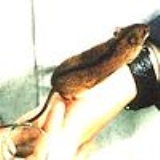
Striped Field Mouse
Encyclopedia
The Striped Field Mouse (Apodemus agrarius) is a rodent
in the family Muridae
. The range of this species stretches from Eastern Europe
to Japan
, including Taiwan
and Siberia
.
Accepted synonyms include Apodemus albostriatus (Bechstein, 1801), Apodemus caucasicus (Kuznetzov, 1944), Apodemus chejuensis (Johnson and Jones, 1955), Apodemus coreae (Thomas, 1908), Apodemus gloveri (Kuroda, 1939), Apodemus harti (Thomas, 1898), Apodemus henrici (Lehmann, 1970), Apodemus insulaemus (Tokuda, 1939 and 1941), Apodemus istrianus (Kryštufek, 1985), Apodemus kahmanni (Malec and Storch, 1963) Apodemus karelicus (Ehrström, 1914), Apodemus maculatus (Bechstein, 1801), Apodemus mantchuricus (Thomas, 1898), Apodemus nicolskii (Charlemagne, 1933), Apodemus nikolskii (Migouline, 1927), Apodemus ningpoensis (Swinhoe, 1870), Apodemus ognevi (Johansen, 1923), Apodemus pallescens (Johnson and Jones, 1955), Apodemus pallidior (Thomas, 1908), Apodemus pratensis (Ockskay, 1831), Apodemus rubens (Oken, 1816), Apodemus septentrionalis (Ognev, 1924), Apodemus tianschanicus (Ognev, 1940) and Apodemus volgensis (Kuznetzov, 1944).
Rodent
Rodentia is an order of mammals also known as rodents, characterised by two continuously growing incisors in the upper and lower jaws which must be kept short by gnawing....
in the family Muridae
Muridae
Muridae is the largest family of mammals. It contains over 600 species found naturally throughout Eurasia, Africa, and Australia. They have been introduced worldwide. The group includes true mice and rats, gerbils, and relatives....
. The range of this species stretches from Eastern Europe
Eastern Europe
Eastern Europe is the eastern part of Europe. The term has widely disparate geopolitical, geographical, cultural and socioeconomic readings, which makes it highly context-dependent and even volatile, and there are "almost as many definitions of Eastern Europe as there are scholars of the region"...
to Japan
Japan
Japan is an island nation in East Asia. Located in the Pacific Ocean, it lies to the east of the Sea of Japan, China, North Korea, South Korea and Russia, stretching from the Sea of Okhotsk in the north to the East China Sea and Taiwan in the south...
, including Taiwan
Taiwan
Taiwan , also known, especially in the past, as Formosa , is the largest island of the same-named island group of East Asia in the western Pacific Ocean and located off the southeastern coast of mainland China. The island forms over 99% of the current territory of the Republic of China following...
and Siberia
Siberia
Siberia is an extensive region constituting almost all of Northern Asia. Comprising the central and eastern portion of the Russian Federation, it was part of the Soviet Union from its beginning, as its predecessor states, the Tsardom of Russia and the Russian Empire, conquered it during the 16th...
.
Accepted synonyms include Apodemus albostriatus (Bechstein, 1801), Apodemus caucasicus (Kuznetzov, 1944), Apodemus chejuensis (Johnson and Jones, 1955), Apodemus coreae (Thomas, 1908), Apodemus gloveri (Kuroda, 1939), Apodemus harti (Thomas, 1898), Apodemus henrici (Lehmann, 1970), Apodemus insulaemus (Tokuda, 1939 and 1941), Apodemus istrianus (Kryštufek, 1985), Apodemus kahmanni (Malec and Storch, 1963) Apodemus karelicus (Ehrström, 1914), Apodemus maculatus (Bechstein, 1801), Apodemus mantchuricus (Thomas, 1898), Apodemus nicolskii (Charlemagne, 1933), Apodemus nikolskii (Migouline, 1927), Apodemus ningpoensis (Swinhoe, 1870), Apodemus ognevi (Johansen, 1923), Apodemus pallescens (Johnson and Jones, 1955), Apodemus pallidior (Thomas, 1908), Apodemus pratensis (Ockskay, 1831), Apodemus rubens (Oken, 1816), Apodemus septentrionalis (Ognev, 1924), Apodemus tianschanicus (Ognev, 1940) and Apodemus volgensis (Kuznetzov, 1944).

